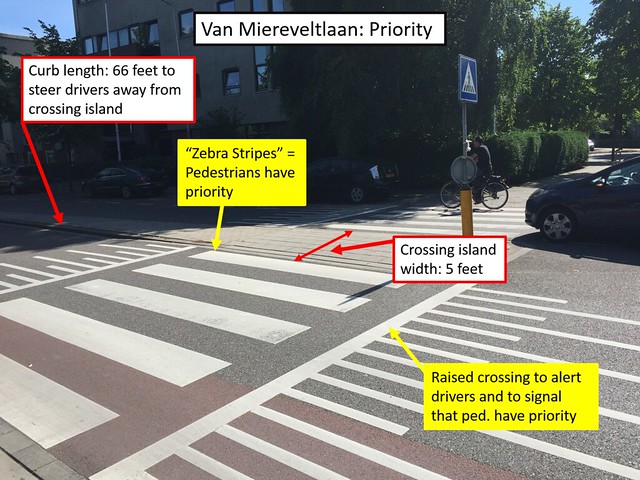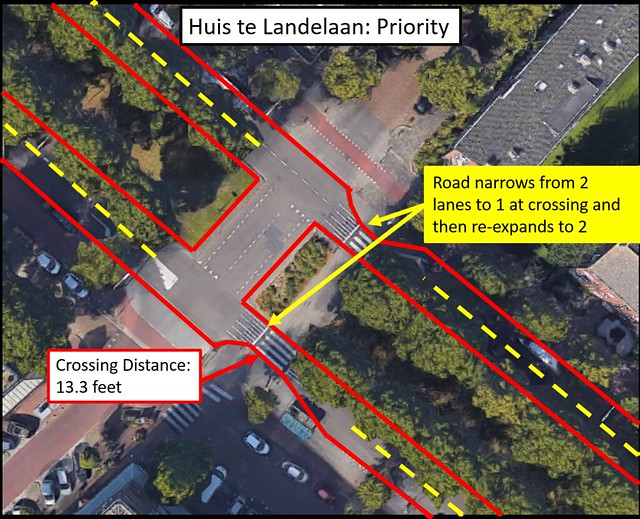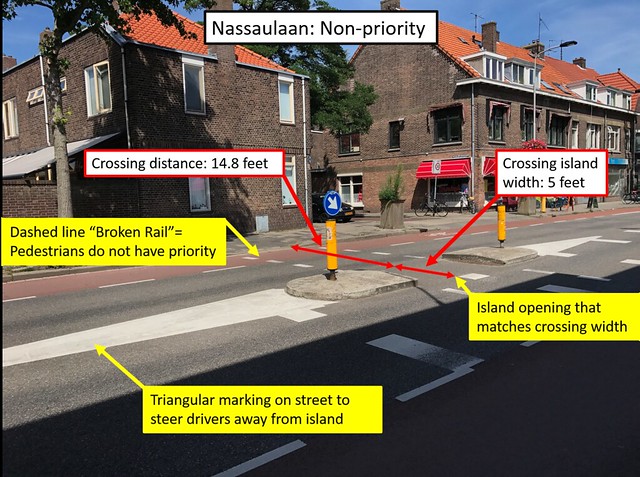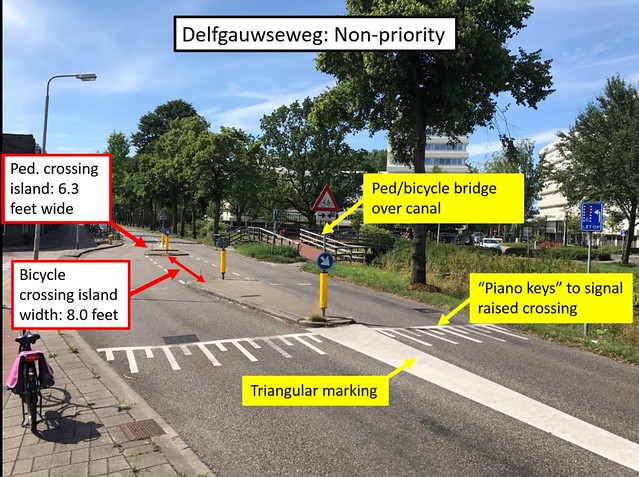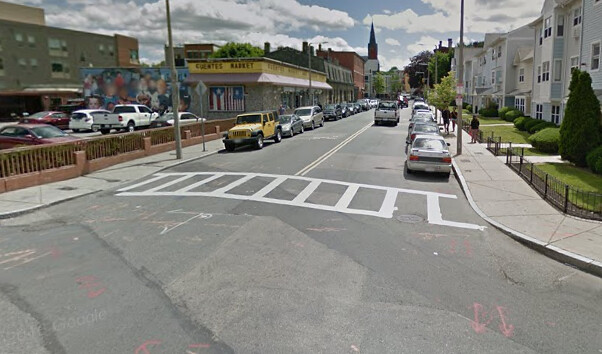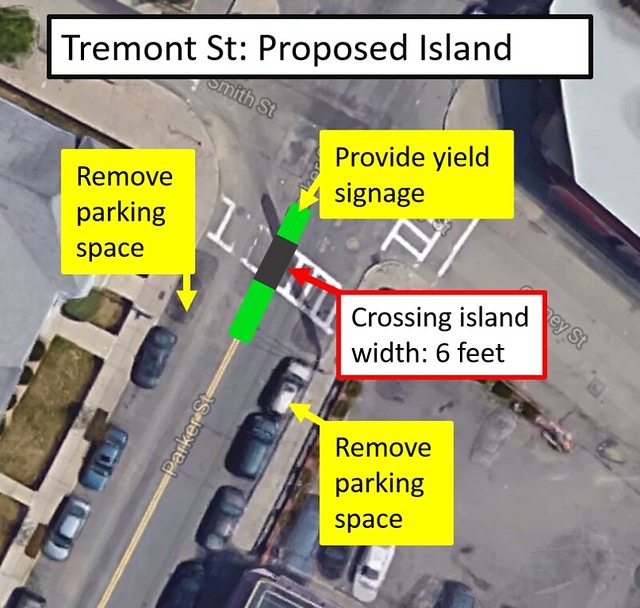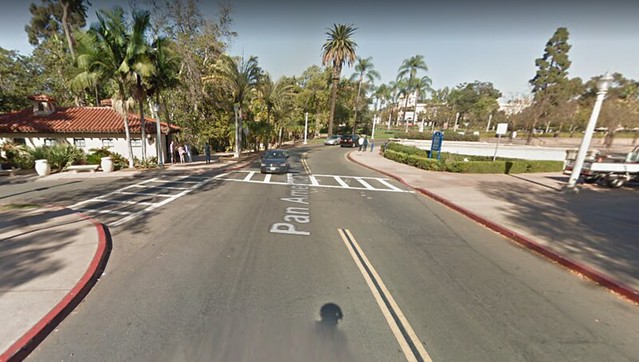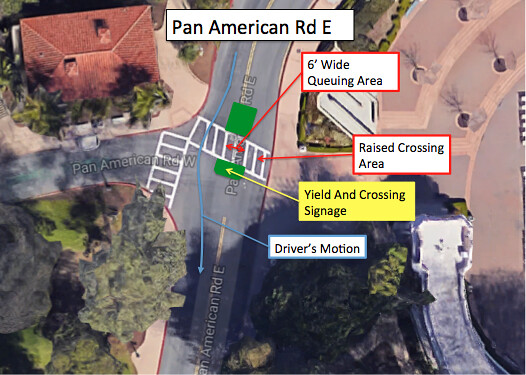3.2 Pedestrians cross only one lane at a time [Nick & Rick]
Video:
Background:
Dutch guidelines state that pedestrians should not have to cross more than two lanes of traffic at a time at unsignalized intersections. The city of Delft is even more stringent and restricts crossings to just one lane at a time. These policies highly contrast the typical scenario in the U.S. where pedestrians are commonly forced to cross two lanes of traffic at time. As a result, double-threat collisions, collisions that occur because the car nearest to the pedestrian stops while the vision of the driver in the far lane is blocked and the driver continues through the crossing, striking the pedestrian, are extremely common. We have found that Delft has followed through with its guidelines at all crossings that we have studied and have thus eliminated the double-threat collision. Limiting the lanes a pedestrian has to cross at one time also increases pedestrians safety by decreasing the crossing distance and thus limiting the amount of time the pedestrian is in a conflict area.
Having pedestrians cross only one lane at a time fits directly into Sustainable Safety as it increases both predictability and simplicity. Pedestrians must only predict the gap time of one car as they only have to cross one lane of motor vehicle traffic at a time. In addition, it also relates to simplicity as pedestrians need to only look for traffic in one direction and do not need to predict the actions of multiple vehicles at a time. Even a child should be able to look and predict the actions of one directional traffic so that they can cross a relatively small distance until the next refuge area.
Two types of unsignalized crossings are found in the Netherlands: priority crossings and non-priority crossings. At priority crossings, the most common type of crossing in the United States, pedestrians force a gap and vehicular traffic must yield. At non-priority crossings, pedestrians simply wait for a gap. Dutch principles aim to use non-priority crossings as they have the least restrictive control over users. Multiple streets were studied both in Delft and in Rijswijk.
Below is a map of all studied crossings:
When to use Priority vs. Non-priority:
Given the choice between using non-priority and priority crossings, the Dutch examine factors such as volume of vehicular traffic, volume of pedestrian traffic, and the buildings in the surrounding area. Generally, on roads with low ADT, crossings are non-priority. This forces pedestrians to wait for a gap, but with low traffic volumes, this wait is often not long. On the other hand, high volume roads often require priority crossings. As a pedestrian, waiting for a gap in high volume traffic could lead to undesirably long wait times.
Along a stretch of roadway in northeast Delft from the beginning of Stalpaert van der Wieleweg to the end of Van Miereveltlaan, both priority and non-priority crossings are used. Along this stretch of roadway, the ADT and travel speed for cars remain roughly constant. This demonstrates that more than traffic volume can impact the decision to use priority or non-priority crossings. In the south, on Stalpaert van der Wieleweg, non-priority crossings give pedestrians a safe place to cross the street. However, on Van Miereveltlaan to the north, priority crossings are provided. A shopping center and a school area are the reason for these priority crossings. The reason for having priority crossings at the school is fairly straightforward: large volumes of children need to cross at once. As for the shopping center, the large volume of foot traffic coming to do their shopping would require vehicular traffic to yield. Furthermore, imagine a pedestrian with heavy bags of groceries having to wait for a gap in traffic. The map below of this stretch of roadway shows the signalized intersection in purple, the non-priority crossings in blue, the priority crossings due to the shopping center in red, and the priority crossings due to the school in green.
Characteristics:
At priority crossings, zebra stripes are always used to notify drivers that they do not have priority. Additionally, crossings are raised so that there is no question a driver is entering a different area. This also acts as a speed hump to motor vehicles, lowering speeds. Even with priority, central crossing islands are still provided for pedestrians along many streets to provide refuge for pedestrians. The break in crossing helps pedestrians identify if it is safe to cross by allowing them to focus on one direction of travel at a time. Interactions between pedestrians and drivers at these crossings help ensure safety. Eye contact and a clear intent to cross from the pedestrian communicate to the driver to yield. Wait time for pedestrians during rush hour consists of waiting for the car currently in the crossing to continue through and the following car almost always yields.
Crossings along Van Miereveltlaan give priority to pedestrians using techniques shown in the above pictures to force vehicle speeds to be low and drivers to be aware that they are entering a pedestrian traveled area. These crossings at Van Mierevetlaan received a lot of traffic. However, giving priority to pedestrians here did not drastically interrupt the flow of the heavy vehicle traffic.
Huis te Landelaan at Dr Colijnlaan was a two plus two road that underwent a road diet. Pedestrians were previously forced to cross two lanes of motor vehicle traffic at a time. Now, pedestrians simply need to cross only one lane at a time, since the road narrows to just one lane at each of the crossings. This eliminates the double threat scenario at these crossings. After using one of the crossings, pedestrians can seek refuge on a large median which is large and green with enough space for park benches.
With residential and commercial buildings adjacent, Ruys de Beerenbrouckstraat is a heavily traveled road for motor, cycle, and foot traffic. Therefore, safe pedestrian crossings are present at multiple locations along the street (e.g. the Albert Heijn grocery store).
Non-priority crossings differ in a few ways:
- Zebra stripes are not present and drivers are alerted through signage and dashed lines that there is a crossing, but they are not forced to yield
- Crossing tables are far less common
- Pedestrians are forced to cross at car level
- No change in pavement color or texture
Here are a few examples of non-priority crossings in Delft.
Along Nassaulaan at a crossing near shops, pedestrians are forced to cross both a car travel lane and a bike lane, due to a narrow right-of-way which could not accommodate a cycle track. At crossings without an island, pedestrians are free to cross as they wish, but they must yield to two lanes of car traffic and two lanes of bicycle traffic. The difficulty of crossing here appeared to be low as there was infrequent car and cycle traffic.
The intersection of Schoemakerstraat and van der Burgweg is an excellent example of a non-priority intersection. The intersection is used primarily by crossing bicycle traffic from the university and as Schoemakerstraat is a through-road, bicycles and pedestrians are forced to yield. The gap time between cars was long enough so that the wait time for crossing pedestrians was low.
At the intersection of Delfgauwseweg and Simonsstraat, there is a crossing with a bridge that has two crossing islands: one for pedestrians and one for bicycles. The islands act not only as a refuge for pedestrians, but they also force cars to ride along an S-curve. In addition to islands, the entire crossing is raised which helps to alert drivers of possible conflicts with pedestrians. As the exit to the bridge is not aligned with the pedestrian islands, it appeared that pedestrians continued straight through the intersection and did not use the island for its intended purpose.
Places in the US where it could be implemented:
Parker Street Boston, MA
Parker street at Gurney Street in Boston has been selected as an intersection where a dutch-style crossing could be incorporated. The street already features zebra stripes signaling that pedestrians have priority. There is currently a somewhat high volume of traffic using the street to reach Roxbury and Mission Hill and there are frequent pedestrian crossings at this location due to the presence of a convenience store. A pedestrian island and a crossing table would vastly improve the crossing experience for pedestrians. The pedestrian island will be 6 feet wide to meet the required 4 feet for ADA requirement and to provide an extra few feet to fit bicycles. The island will feature curb lines extending past it similar to Nassaulaan to force cars along an S-curve and to steer drivers away from the island itself. The combination of the S-curve and crossing table will slow and alert drivers of the potential conflict with pedestrians.
Pan American Rd. East, San Diego, CA
Pan American Road in the heart of San Diego’s Balboa Park is a wonderful U.S. candidate for simple crossings. It cuts through a large pedestrian area featuring a ampitheater, old architecture, a Japanese Botanical Garden, and access to many museums. Currently, pedestrians are given priority along this stretch of roadway using a zebra-striped crosswalk. Fast speeds and impatient drivers create an extremely stressful environment for pedestrians. A Dutch style crossing would improve safety in this location and decrease the stress involved in crossing the street. Raised crossings, and a central crossing island would help simplify the crossing for the pedestrians and allow them to only focus on crossing one direction of travel at a time. With the high volume of foot traffic, the crossing would still give pedestrians priority, so they would not have to wait for a gap in the oncoming traffic. Since the road currently features two 13 foot lanes which can be narrowed, finding space for the crossing island would not be a concern.


